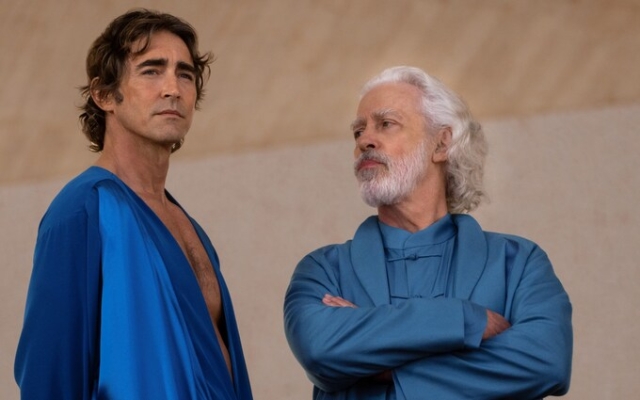 Immortal: Lee Pace as the ruthless Emperor Kleon with Terrence Mann as the clone Brother of Twilight Credit: Patrick Redmond
Immortal: Lee Pace as the ruthless Emperor Kleon with Terrence Mann as the clone Brother of Twilight Credit: Patrick Redmond
The Emperor has no clothes. However, he has a pressing problem: the masked killer interrupted him while he was at the crime scene with his robot lover. Talk about naked awakening. Frowning in amusement, he fends off the assassin using his synthetic lover as a shield. She loses her head, but the Emperor keeps her cool and defeats her attacker. Five minutes into the second season of Apple's $45 million film adaptation of Isaac Asimov's Foundation, we've already reached the peak of the frenzy.
Or are we? The naked emperor (Lee Pace) and his ruined bedroom are just the beginning of the interstellar madness. A few scenes later, mathematical prodigy Gaal Dornik (Lou Llobell) is awakened from a deep cosmic slumber by his dashing daughter, Salvor Hardin (Leah Henry). Due to the vagaries of interstellar travel, the child is several years older than the mother. Meanwhile, mathematician genius Hari Seldon (Jared Harris) has been reincarnated as a digital simulacrum, stuck in some kind of advanced Rubik's Cube. This is Salvador Dali's Doctor Who.
Naked robot fights are not what fans of Asimov's cerebral novels had in mind when it was announced that The Dark Knight writer David S. Goyer would bring the Foundation saga to the screen. Originally published in the 1940s, the early Founding articles are considered a classic example of the «Golden Age of Science Fiction» when writers like Asimov questioned humanity's relationship with technology and the distant future.
As the child of Jewish immigrants from Smolensk, New York, Asimov was fascinated by the rise and fall of empires. Just as Rome had conquered Europe, so, he imagined, a galactic empire could dominate a future universe where humanity would be seeded among the stars. But what happens when this empire inevitably begins to fall apart? Tens of thousands of planets will plunge into a new dark age. Is it possible to keep any of the old ways? If so, how?
These were the questions asked by Hari Seldon, Asimov's second in command, who at the beginning of the Foundation is developing a new science of «psychohistory» — a means of extrapolating current trends in predicting where society is heading. The author was inspired by history. But equally in chemistry (later he became a professor of biochemistry, on which he lectured at Boston University).
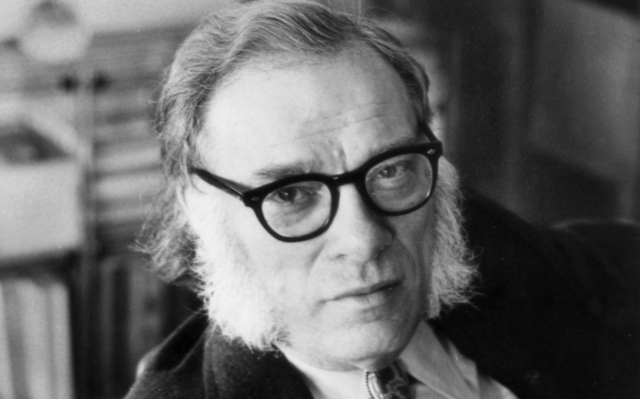 Biochemist Isaac Asimov, pictured c. In the 1970s, he was inspired by science to write his Foundation series. Credit: Mondadori Portfolio
Biochemist Isaac Asimov, pictured c. In the 1970s, he was inspired by science to write his Foundation series. Credit: Mondadori Portfolio
“At the time I started these stories, I was studying physical chemistry at school, and I knew that since the individual molecules of a gas move in a rather chaotic and random way, no one can predict the direction of movement of an individual molecule at any particular moment in time,” Asimov said in an interview in 1987. “The characterization of their motion works to the point where you can very accurately predict the overall behavior of a gas using gas laws. I knew that if the volume was turned down, the pressure would rise; If you raise the temperature, the pressure will rise and the volume will increase. We know these things even if we don't know how individual molecules behave.
Empires were like clumps of molecules. At the macro level, one could predict how they would behave. “It seemed to me that if we really had a galactic empire, then there would be so many people — quintillions — that perhaps you could predict very accurately how societies would behave, even if you could not predict how the individual people who make up these societies would behave.
“So, against the background of the Roman Empire, written in large, I invented the science of psychohistory. Everywhere…there are opposing forces of individual desire and that dead hand of social inevitability. Dream of a mad fever: Jared Harris as psychohistory developer Hari Seldon in The Foundation
He expounded this idea, first in short stories—the early Foundation books were anthologies of shorter works published in Amazing Science Fiction—and then in a series of best-selling novels. The series has its share of action; the pace picks up especially when a mind-reading villain named the Mule appears. But these books inherently revolve around big ideas about history, sociology, and human behavior.
The word «psychohistory» appears in the Foundation series. Still, in tone and theme, the show couldn't be further from Asimov's sober science fiction. Although it tells the same basic story of Seldon's attempts to establish a «Foundation» colony that will protect civilization when the Empire collapses, in execution it moves in the opposite direction of the author, at the speed of light.
Seldon is confronted by a ruthless Emperor who will stop at nothing to stop him from making his doomsday predictions about the Imperium public. If he wants to save civilization, he will have to fight the Empire as well. This leads to stunning sets (the destruction of the huge «space elevator» above the Imperial capital of Trantor) and intricate performances.
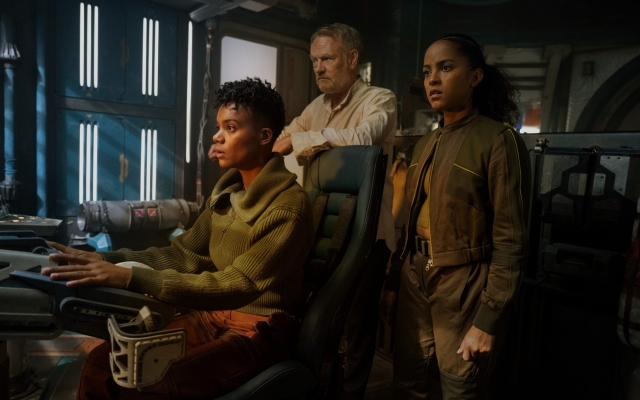 Jared Harris (center) plays Hari Seldon with Leah Harvey and Lou Llobell in Foundation Series 2 Credit & Copyright: Helen Sloan
Jared Harris (center) plays Hari Seldon with Leah Harvey and Lou Llobell in Foundation Series 2 Credit & Copyright: Helen Sloan
This turn from cautious to insane turns out to be the creation of the Foundation. With a history spanning centuries, the books were long considered unsuitable for film adaptation. Goyer's key innovation was the recognition that Asimov could not be transferred to the screen. Instead, he turns the Foundation into a mad fever dream.
Much of the fever comes from Lee Pace as Immortal Emperor Kleon. Gonzo cyberpunk Julius Caesar Cleon is never mentioned in the original Foundation novels (he has a cameo in the prequel). In the series, he becomes the immortal guardian of the Empire.
He is a clone who rules in three incarnations: a young man (Dawn), a middle-aged man (Day) and an older man (Sunset). Dawn, Day and Dusk are a powerful trio like no other. Pace doesn't so much chew the landscape as he chews it up in big, meaty chunks like Day, a paranoid despot trying to keep the Empire together and prevent Seldon's prediction that it's about to collapse.
 Imperial Rule: Cooper Carter, Lee Pace and Terrence Mann in The Foundation Credit: Helen Sloan
Imperial Rule: Cooper Carter, Lee Pace and Terrence Mann in The Foundation Credit: Helen Sloan
It is Pace who frolics with a robot and then uses the robot to fend off an assassin. This is all the working day of the actor. He is a fan of fantasy and science fiction, admiring Goyer's adaptation of the non-adaptable book.
“I read Foundation about a year before I heard Skydance [Goyer's production company] was working on a series and I thought, 'There's no way they can handle this. It's too big. Ideas are too complex,” Pace said in an interview with Empire. “How to tell a story that is over 1000 years old? It's too much.”
Goyer could have tried to pay homage to the original Foundation. Instead, he dared to create something completely different. He created screamingly insane sci-fi that, with its mixture of special effects and absurd acting, is reminiscent of Monty Python's Star Wars remake.

The showrunner called Foundation a «remix» of the books. Joyful deconstruction might be the best way to put it. What a pity that the Foundation has not gained wider recognition as a reckless pleasure. The first series received poor reviews — «bloated sci-fi scum,» the newspaper wrote. The second season, which was released on July 14, attracted almost no attention.
Moreover, Apple, like all streamers, refuses to share viewing numbers. So it's impossible to tell whether Foundation is a cult hit or a costly flop (Goyer says it was «pretty successful» for Apple). It can be said that the Foundation, with its naked emperors and scientist-philosophers, locked in interstellar Rubik's cubes, is like nothing else. It's a brilliantly crazy journey beyond sci-fi — and a response to the formulaic superhero sleep fests that are all too often mistaken for escapism these days.
Have you watched Foundation? Share your thoughts in the comments section below















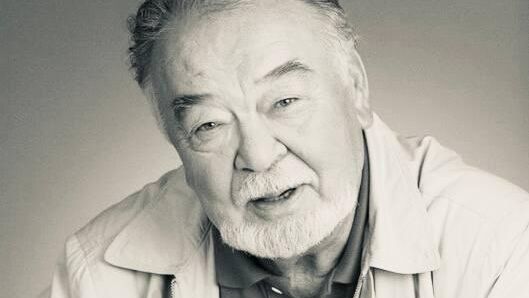



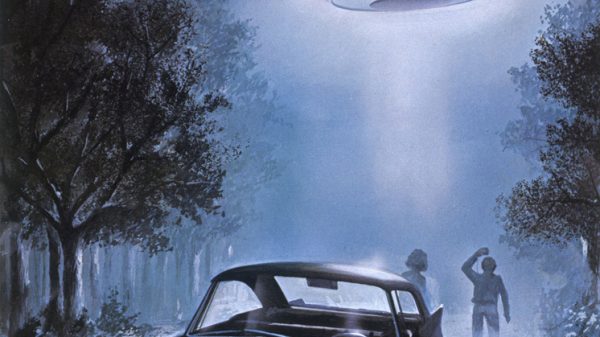

































Свежие комментарии